“The creative process is like music which takes root with extraordinary force and rapidity.”
– Peter Ilych Tchaikovsky, Composer
Buenos Aires – Mandioca. Cassava. Manioc. Yuca. Tapioca. Manihot. Aipim. Boba. Macaxeira. Chhiū-chï. Balinghoy. Singkong. Pokok ubi kayu. Sắn. A tuber by any other name would still be a root in the ground, no? Here, we call it mandioca, or at least most folk do, if they think of it at all. Mostly, I’d guess, other than the “first peoples” population (that’s the terminology Henry has now informed me is the politically correct one for what we tend to call Indian or indigenous populations), folks just see it at a local vegetable stand, have no clue, and proceed to ignore its existence. As promised, however, I’m going to introduce you to it. In the U.S. we probably know it best from the starch that’s extracted from the dried root – tapioca. Pudding and all that. Worldwide however, it’s one of the most important staple foods (third largest source of carbohydrates on the planet) – mostly southern hemisphere – South America and Africa – but not limited to those areas. One note, the “yucca” plant, with two c’s, is actually a different plant from the “yuca” with one c – though I’ve seen the double c used many times to refer to this root.
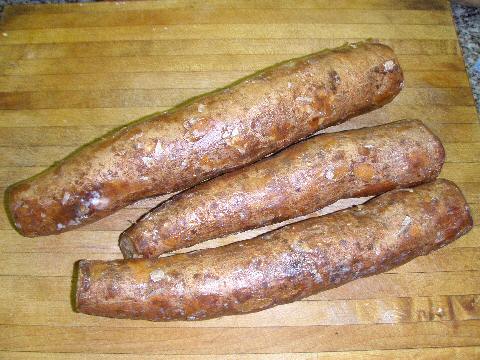
When found fresh, it’s a long, usually approximately a foot long, slightly warped cylinder covered in a somewhat shiny light brown skin. There are two types of mandioca, officially, “sweet” and “bitter”. The former is what we’re concerned with, as both contain some level of natural cyanide – simple cooking eliminates the poison from the root of the sweet, a much more intensive processing is required to remove it from the bitter – what you’ll find on the vegetable stands as an ingredient to cook with will be the sweet.
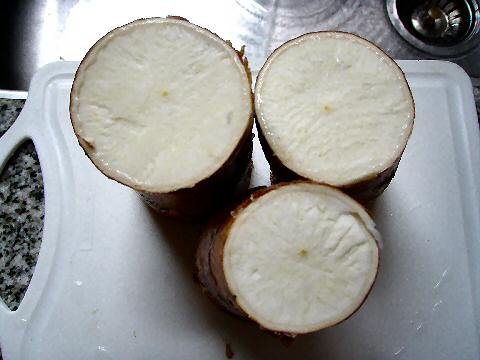
If you cut them in cross section, you can see that the outer skin is very thin, then there’s a slightly thicker inner skin, and then the flesh that we’ll be preparing. It’s white in color, varying from a sort of cream color to very stark white, and has the consistency of something like a raw sweet potato. I usually trim off the ends and then cut them into sections about 3-4″ long, because they’re easier to work with.
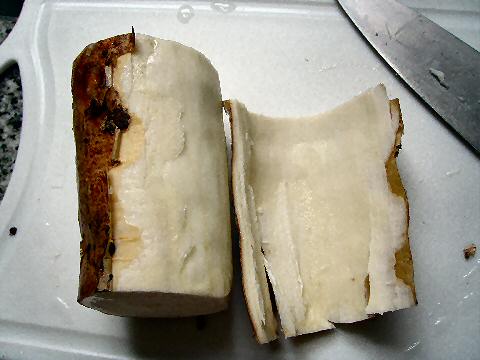
Assuming the roots are fresh and not all dried out (in which case you may as well throw them out), they’re actually pretty easy to peel – use a medium length knife, and cut into the skin so that you cut through both the outer and inner parts. Then angle the knife to get under and lift the two layers and simply start rotating the cylinder of root. It takes a little practice, but in truth, if the roots are nice and fresh, you can pretty much peel off the whole skin in a single piece. I stopped part way around so that you can see the two layers – note that the inner skin layer begins to discolor almost immediately on exposure to the air – turning a sort of rust brown color – which is actually good, because you can see where you missed any that needs to be removed. The flesh stays nice and white, at least for awhile – I usually peel with a bit of running water going to rinse away any bits of inner skin.
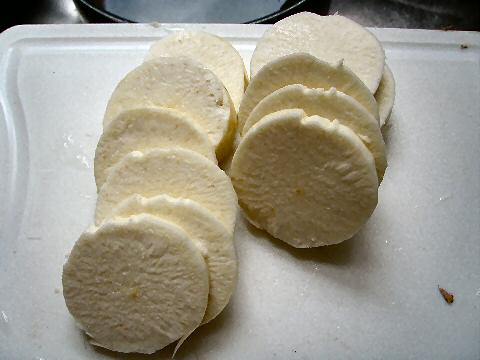
At this point it depends what you’re going to do with the root as to how to cut it – you’ve seen in past posts that we often split these lengthwise into quarters or sixths, to accompany things like a ceviche. They can be cut into french fry shapes. Or, like here, they can be cut in disks… or, well, any shape you feel like, really – a few weeks ago I simply diced them into pieces small enough to mash up after cooking to make a yuca souffle. The usual process then is to boil them until they’re soft, though I’m told that in Brazil it’s common to slice them like this, but much thinner, almost like a thick cut potato chip, and simply deep fry them, which is enough cooking to apparently destroy the cyanide (or maybe they boil them first, dry them, and then fry them – something to check up on).
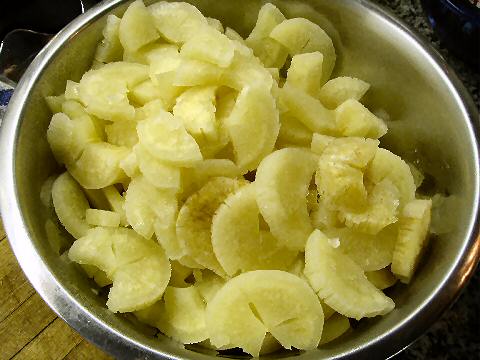
Because I wanted these cooked thoroughly, I cooked the slices to the point where they’re soft enough they start to break apart. I’m guessing that if you want them to maintain their disk shape, you can cook them a little less, keeping the cross sections intact, and then proceed to do whatever else it is you’re planning on. In this case, we used these as an accompaniment to pork chops for last week’s Cuban-American dinner, by taking a good quantity of olive oil, sauteeing a whole lot of garlic and some onion in it, and then tossing the mandioca “chips” with the oil mixture, just enough to thoroughly coat them and rewarm them.
We were just talking about these in the store – thanks for all the good information!
[…] not a dish we’d done before, regular readers know I’ve been experimenting alot with yuca root recently. And I decided on a yuca soup – which will be the focus of the rest of this post, at least […]
[…] the duck legs went back into the sauce, reheated to just a simmer. While traditionally served with yuca root, it’s out of season here, and what’s available is fibrous and/or rotting – so simple […]
[…] soup of fish cooked in coconut milk. We have here… coconut milk, green plantains, taro root, cassava root, bell peppers, cilantro, onion, rocoto (again, in place of habanero), garlic, salt, pepper, and […]
[…] peeled the root (actually, this was a large root, I only used half of it) – details of how to work with mandioca can be found here. As usual, too many variations on the recipe to come up with one set standard, but in the end, […]
[…] cuisine relies heavily on corn. Yuca also has a strong presence. Not suprisingly, the cooking has its roots in the various indigenous […]
[…] yucca – you’ve seen me use this root before, it’s common in Andean cooking, and I have a step-by-step writeup on how to prep it from a good 16 years ago. Now, there are a trio of versions of pissoj, […]